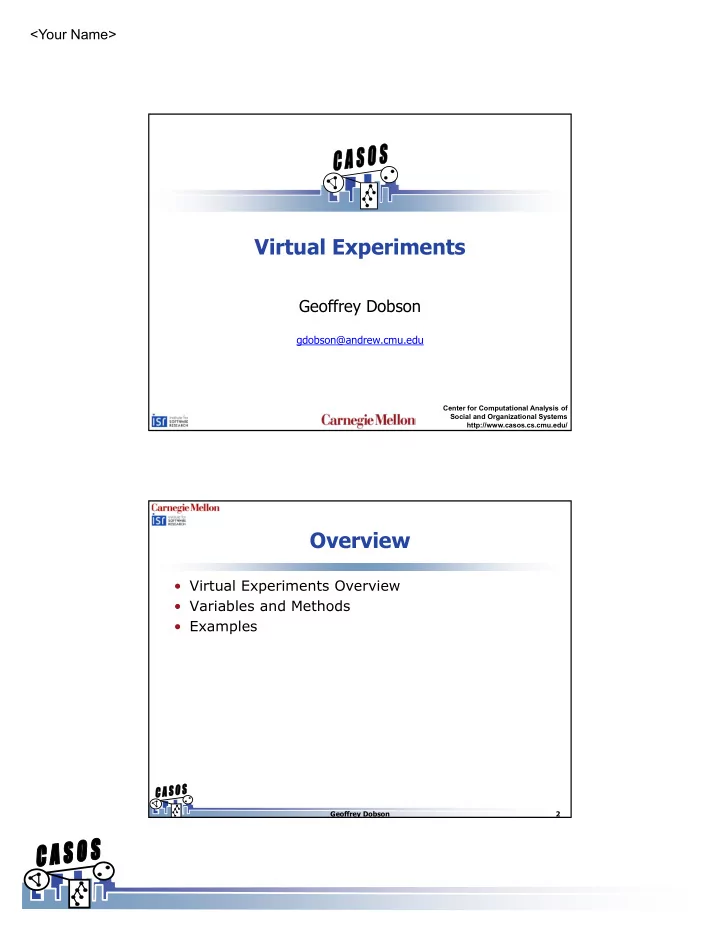

<Your Name> Virtual Experiments Geoffrey Dobson gdobson@andrew.cmu.edu Center for Computational Analysis of Social and Organizational Systems http://www.casos.cs.cmu.edu/ Overview • Virtual Experiments Overview • Variables and Methods • Examples Geoffrey Dobson 2 1
<Your Name> Virtual Experiments • Virtual Experiments – Test a model, not reality – Model should be as close to reality as possible – “All models are wrong, but some are useful” - George EP Box – Good for testing assumptions – Good for what-if analysis – Good for generating hypotheses Geoffrey Dobson 3 Why Virtual Experiments? • Real Experiments – Expensive - (Spaceship launches) – Unethical - (What if spray poison gas on Pittsburgh?) – Infeasible - (Bridge hold up if 500 concrete trucks on it?) • Don’t use Virtual Experiments: – When you’re looking for ‘truths’ and not ‘trends’ – When you can get what you want from a survey Geoffrey Dobson 4 2
<Your Name> Cost of Virtual Experiments • Virtual Experiments can be expensive! – Buy data – Buy software – Buy computing power – Cost of coding the model, maintaining the code – Human Resources Geoffrey Dobson 5 Virtual Experiment Design Many of the same problems and challenges of real experiments! • Dependent Variables • Independent Variables • Method of experiment • Control Conditions • Generality • Power Geoffrey Dobson 6 3
<Your Name> Independent Variables • What am I changing run to run? • How many different independent variables? • BE CAREFUL! – Too many combinations can be difficult to interpret – Too many combinations could take time, ie - years, to complete the simulation Geoffrey Dobson 7 Dependent Variables • What am I measuring? • What does this imply in the real world? • Is the independent variable manipulation believable , as it relates to the dependent variable? • Usually best narrow down the dependent variables to just a few Geoffrey Dobson 8 4
<Your Name> Method • Most of the “method” is - explaining the control variables, and how the independent variables are manipulated • Strategies for manipulation of independent variables – Set them to create a baseline – Set them to show when there is no impact – Set them to show best/worst case – Set them randomly across an appropriate distribution • Has anyone done virtual experiments? Geoffrey Dobson 9 Control Conditions • Control Conditions, often, are independent variables that are not changing, or changing in a controlled manner • EG - In network topologies, ER Random networks are often used as control conditions • EG - Holding a temperature constant in climate models • EG - Holding Windows server vulnerability growth rate within a distribution between 1 - 3% in cyber security models Geoffrey Dobson 10 5
<Your Name> Generality • Defining model parameters can become very specific – Best to draw from literature when possible! • EG - Examining network information flow after actor removal – Bad example • Case 1: Remove Gordon • Case 2: Remove Jill • Case 3: Remove Pat – Good example • Case 1: Remove Actor with highest degree centrality • Case 2: Remove Actor with highest betweenness centrality • Case 3: Remove Actor with highest eigenvector centrality Geoffrey Dobson 11 Power • Given enough repetitions, even trivial differences between simulation conditions will produce statistically significant results. • It’s important to focus on trends, rather than specific values. – Wrong: Because of the manipulation condition, Y increases by 5%. – Better: Y tends to increase under the manipulation condition. • A reasonable heuristic is 25 repetitions per combination Geoffrey Dobson 12 6
<Your Name> Example 1 How does varying the degree of ethnocentrism in an artificial society affects the formation of social relationships across social groups under different models of the underlying cultural structure? Joseph, K., Morgan, G. P., Martin, M. K., & Carley, K. M. (2013). On the Coevolution of Stereotype, Culture, and Social Relationships: An Agent-Based Model. Social Science Computer Review . Geoffrey Dobson 13 Virtual Experiment Geoffrey Dobson 14 7
<Your Name> Analyzing the results • Run the simulation • Construct a network of who talked to who more than N (N=2 here) times • Look at the log-odds of a tie to a member of the outgroup Geoffrey Dobson 15 Results from VE Geoffrey Dobson 16 8
<Your Name> Results from VE Figure 5a) The mean number of group schemas that agents held across all conditions. 5b) The mean number of knowledge bits that the generalized other schema had set to 1 across all agents in the group based and uniform knowledge conditions only. Error bars are 95% bootstrapped confidence intervals Geoffrey Dobson 17 Results from VE Geoffrey Dobson 18 9
<Your Name> Conclusions from VE • Results suggested that neither stereotypes nor the form of underlying cultural structures alone are sufficient to explain the extent of social relationships across social groups • Rather, we provide evidence that shared culture, social relations and group stereotypes all intermingle to produce macro-social structure. Geoffrey Dobson 19 Example 2 How many cyber forces should we deploy to minimize the effect of a routing protocol attack (RPA)? Dobson, G. B., & Carley, K. M. (2017, July). Cyber-FIT: An Agent-Based Modelling Approach to Simulating Cyber Warfare. In International Conference on Social Computing, Behavioral-Cultural Modeling and Prediction and Behavior Representation in Modeling and Simulation (pp. 139-148). Springer, Cham. Geoffrey Dobson 20 10
<Your Name> Example 2 Independent Variables IV Variants Specific Values DCO Forces 12 1, 2, 3, 4, …12 Control Variables CV Variants Specific Values Exploit Success Rate 1 4 Attack Type 1 RPA Vulnerability Growth Rate 1 5 Dependent Variables DV Variable Type Vulnerability Rate Continuous Compromise Rate Continuous Repetitions Number of Repetitions 30 Total Runs 12*1*1*1*30 = 360 Geoffrey Dobson 21 Example 2 Geoffrey Dobson 22 11
Recommend
More recommend